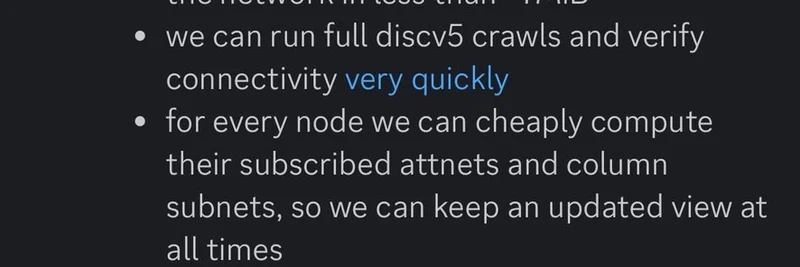Ethereum's peer-to-peer (P2P) networking is on the cusp of a major upgrade, and if you're knee-deep in blockchain tech—or just dipping your toes into meme token ecosystems built on Ethereum—this could change how you think about network speed and reliability. In a recent thread, Raúl (@raulvk), the P2P networking lead at the Ethereum Foundation, dropped some fire insights on "tactical peering." It's not just jargon; it's a game-changer for how Ethereum clients connect, gossip, and validate blocks faster than ever.
Think of Ethereum's network like a massive, decentralized cocktail party. Right now, nodes (your validators or clients) are randomly picking conversation partners, leading to chit-chat delays and missed opportunities. Tactical peering? That's like giving everyone a smartwatch that whispers, "Hey, connect with that low-latency validator over there who's already tuned into the right subnet." The result: smoother block propagation, lower latency, and a more resilient network overall.
Raúl's thread highlights how the Prysm team—shoutout to Aarsh and Kasey—is already simmering this in their labs. Let's break down the core ideas, straight from the source.
The Compact Network View: Less Than 7MB of Magic
At the heart of tactical peering is a super-efficient way to map the entire Ethereum consensus layer (CL) network. With around 13,000 peers, each node's ENR (Ethereum Node Record—a fancy ID card with connection details) clocks in at about 300 bytes, plus 64 bytes for the NodeID and some metadata. Crunch the numbers, and boom: the full network snapshot fits in under 7MB.
Why does this matter? It means your client can maintain a real-time, bird's-eye view without guzzling RAM. No more blind groping in the dark—nodes know exactly who's out there.
Discv5 Crawls: Verifying Connections at Warp Speed
Enter discv5, Ethereum's discovery protocol (think of it as a blockchain Yellow Pages on steroids). Raúl points out that full discv5 crawls—scanning the network for active peers—happen blazingly fast. This isn't just theoretical; it's battle-tested for verifying connectivity on the fly.
Pair that with cheap computations for each node's subscribed attnets (attestation networks) and column subnets (groups handling specific duties), and you've got an always-updated peer directory. It's like having a GPS for validators: always knowing the best route before you even hit the road.
Duty Prep: Targeting the Right Peers, No Guesswork
When it's time for your validator to attest (basically, vote on the chain's state), why waste cycles dialing random numbers? With this knowledge base, clients can laser-focus on peers already servicing the relevant subnets. It's targeted outreach, reducing handshake overhead and speeding up consensus.
And looking ahead? Raúl teases near-future upgrades with QUIC session resumption and 0-RTT (zero round-trip time) handshakes. In plain English: reconnect without the full intro ritual—just fire off the message and go. This could slash connection times dramatically, making Ethereum feel even more instantaneous.
Extra Features on the Horizon: Buckets, RTT, and Anonymity
Raúl doesn't stop at the basics. His thread dives into experimental bells and whistles that could redefine Eth networking:
- Purpose-Based Quotas: Slice up your peer table into buckets for specific jobs—like low-latency block relays or maximizing reach into the next attestation subnet.
- Altruistic Slots: Reserve spots for newcomers, helping them bootstrap and sync without hogging resources from pros.
- RTT Tracking: Measure round-trip times as a core metric (props to @soispoke for the ideas), so you always prioritize the quickest connections.
- Proof of Validator Prioritization: Using prototypes from @asn_d6's crypto squad, score peers based on their validator creds—without spilling secrets.
- Oblivious Routing Tables: Boost anonymity by shuffling peer views, keeping slashers and spies at bay.
- QUIC Token Swaps and Persistence: Exchange session tokens for quick resumes, and securely reseed on restarts for faster cold boots.
As Raúl wraps it: "In a year, we will not recognize Eth networking I swear 🌟." Bold claim, but with the Ethereum Foundation's P2P acceleration crew pushing boundaries, it's not hyperbole.
Why This Rocks for Meme Token Builders and Validators
If you're building or trading meme tokens on Ethereum—like those viral pups or frog armies—this trickles down to you. Faster networks mean snappier DEX trades, lower gas during pumps, and more reliable oracle feeds for your wild DeFi experiments. Validators get efficient, reducing the risk of missing attestations and penalties. And for the broader ecosystem? It's a step toward Ethereum swallowing the world, one optimized peer at a time.
The replies in Raúl's thread echo the hype: from excitement over latency drops (@iamjosephyoung) to nods on attack resistance (@0xgilbert). Even the Book of Ethereum account poetically calls it "intelligence emerging at the protocol level."
Keep an eye on Prysm's v6.1.2 updates—they're where this tactical magic first deploys. Ethereum's not just scaling; it's getting smarter. What's your take—will this make Eth the undisputed king of L1s? Drop your thoughts below, and let's geek out on P2P futures.
Follow Meme Insider for the latest in meme token tech, blockchain deep dives, and everything making crypto fun(ky).



